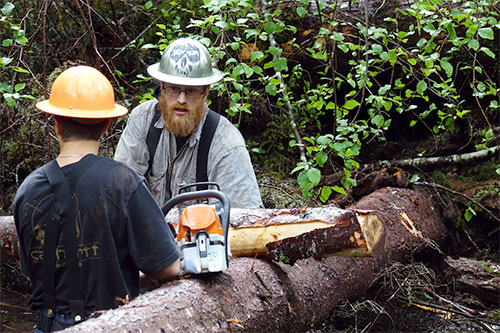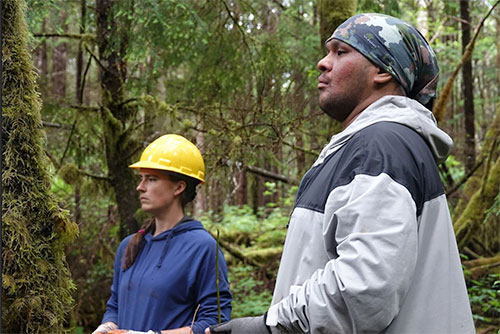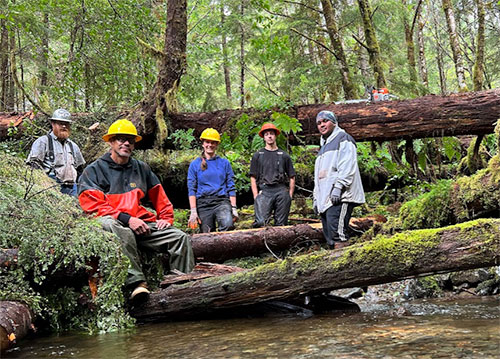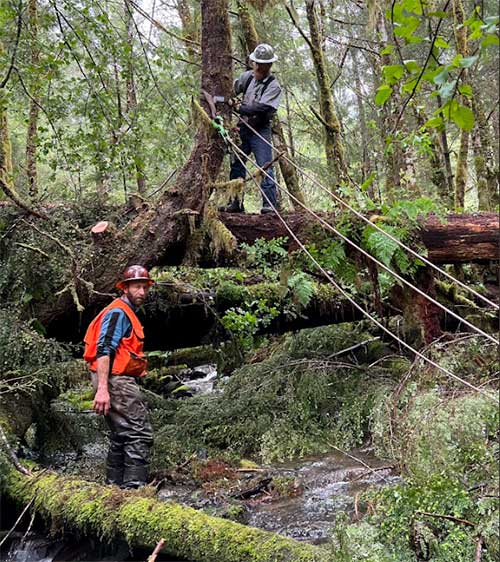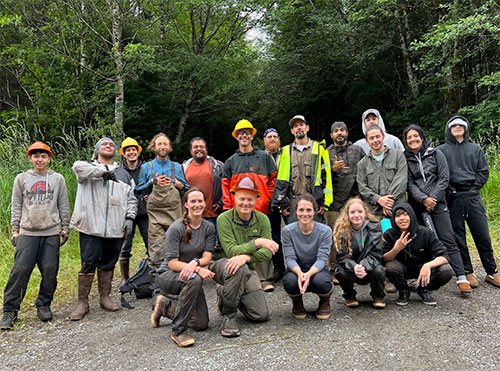
The Salmon StateBringing the sockeye homeKlawock Indigenous Stewards and partners are restoring damaged salmon streams — and working to rebuild Klawock Lake’s once prolific sockeye salmon runBy MARY CATHARINE MARTIN
August 08, 2022
Thirty years after that hunting trip, Aboudara is part of the Klawock Indigenous Stewards Forest Partnership (KISFP). Recently, he and his crew were out on a logging road doing stream reconnaissance and mapping — and he realized he was standing on the same road he had walked with his father.
“I realized I’ll never see that area be old growth again,” he said. “My grandkids maybe will get to see something that was similar to what I saw. But it won’t be the same forest.” “Our forests are resilient,” Aboudara continued. “But they have to be properly managed. And we cannot repeat the actions of previous generations. We can’t make the same mistakes.” Restoring damaged creeks On a recent day, the KISFP crew, as well as a forest partnership crew from Keex’ Kwáan Community Forest Partnership, the team at the Southeast Alaska Watershed Coalition (SAWC), and Alaska Youth Stewards, were out at Seven-Mile Creek, just a few hundred feet from where the stream flows into Klawock Lake. The area was clearcut in 1987. Enormous moss-covered trees as wide as a person is tall lay along the forest floor, left behind after logging. Moss-covered second growth rose into the air, spindly against the girth of massive stumps. And the restoration crew — some of whom are loggers, some of whom are new to the work, and some of whom, like Aboudara, regard their work not just as a full-time, year-round job but as a calling — were using capstan winches, ropes, pulleys, chainsaws and hard work to add logs and wood back into the stream.
“You can see the decline of all the fish populations through the years, how this (clearcut logging) affected it,” said crew member Jon Carle, who has worked at a mill, in tree thinning, in road-building for logging operations, and as a fisherman, and is now the Indigenous Stewards Coordinator with the Prince of Wales Tribal Conservation District. “These trees are forty years old. For forty years, fish didn’t really have any real cover or anything. It was just a clearcut. There was nothing left on the stream.” After a clearcut, there’s an initial boom of berry bushes and other undergrowth-type plants. Then spruce and hemlock regrow all at the same height, locking out light and slowing growth. There is no food for deer or other animals, little to no shade for streams, and there are no branches or trees to fall into a stream, which helps create deep pools, rearing areas, and healthy habitat. “If you go to a stream that’s in the old growth, there’s branches as big as some of the trees we’re trying to pull in here that have broken off and fallen in,” said Carle, who was working on the project as a supervisor and mentor attached to the Klawock partnership through the Organized Village of Kasaan. “The stream is just piled with big, large wood. And so we’re trying to replicate that.” Fishing and the forest, Carle said, “all ties in. You’ve got to have the forest, so the fish can get up. Once one depletes, you see the other going. It all ties together.” Sockeye salmon In Klawock, people have seen that tie-in first-hand. When he was younger, Carle remembers dipnetting for salmon right off the beach. For a month straight, he said, Klawock would smell of salmon as they spawned, washed downriver, and washed up on the beach. In the creeks, “the fish were going through so much you were able to come here and just snag them, or grab them with your hands.”
Back in 1868, the first salmon saltery and cannery in Alaska was built in Klawock Inlet. In the early 1900s, cannery records show a commercial harvest of 80,000 sockeye. Last year, about 3,400 sockeye salmon made it up the river, Aboudara said. The community worked together with scientists from Juneau to make a plan to help the fish. This project is one piece of the Klawock Lake Sockeye Salmon Action Plan, authored by the Southeast Alaska Watershed Coalition, the Nature Conservancy, and Kai Environmental Consulting Services, in consultation with tribal, Native corporation, government, non-profit, and private sector partners. “The Indigenous people of Klawock are sockeye salmon people. And to have these kinds of declines, to have this kind of impact in my own lifetime, let alone the generation before, it’s detrimental. It hurts our spirit. We’re doing our (best) out here to help at least give the sockeye a bit more of a fighting chance so that future generations will know what it’s like to have these fish,” he said. Steady jobs There is another benefit, as well: doing restoration work, said Jon Carle, is a more regular, better paying job than most he has had. “You’re in your own element, and you’re in your office, no matter where you are,” he said as he oversaw the placement of a tree. “The most rewarding part about this particular job is just seeing it all come together. This work keeps the same crew together, keeps everybody employed. Instead of trying to find a new crew, and trying to figure out everything every couple of months, it’s like clockwork.”
After decades of old growth clearcut logging on Southeast Alaska’s largest island, much of it prior to the Tongass Timber Reform Act of 1992, which mandated 100 foot buffers of trees be left along stream banks on federal lands, there’s also an enormous need for restoration, Carle said. (Buffers are not always that big: on state and private lands, the Alaska Forest Practices Act requires only a 66-foot buffer, but taking trees from that area was also sometimes allowed.) “The logging industry… is not going to get bigger,” Carle said. But “there’s always going to be a need for restoration.” That need isn’t just long-term — it’s also year-round. “Things like logging, and thinning, and even surveying skills — they’ve been treated as seasonal employment,” Aboudara said. “So you’ll have people that work three to six months out of the year, and then they get laid off. With the (Klawock Indigenous Stewards) we are doing year-round work, so that we can continue practicing those skills, we can continue keeping those skills. … Instead of going from boom and bust economy, we could have a steady economy.” The Klawock partnership, housed at Shaan Seet Corporation, got its official start this April, funded by USDA Sustainability Strategy money. This year, it’s employing 6 people, all local. Aboudara, who is the stewardship coordinator of the corporation’s Natural Resources Division, hopes that next year the partnership will employ 9. Kaagwaan Eesh Manuel Rose-Bell of Kake was on site, training and working his first week as a member of Kake’s restoration crew, Keex’ Kwáan Community Forest Partnership. He likes that they’re out restoring something, as opposed to taking something, he said. “I heard a lot about the work from my brothers, who worked on the crew in the past few years, so I signed up,” he said. “And I’m really glad I did.” “It’s such a broad vision,” said Xavier Friday, also of Kake. “And it’s brand new. And to be at the beginning of something like this is pretty awesome.” Incorporating Indigenous knowledge The Klawock Indigenous Stewards Forest Partnership is also part of another important transition — ensuring Indigenous voices, and knowledge, are part of decision-making and management in Southeast Alaska. “We use traditional ecological knowledge in our work. We go back into the historical practices. And we also take lessons from nature every day,” Aboudara said. “And that’s so powerful on so many different levels… We need to be voices in the management of our lands. Not to be told two months before they decide to do a timber sale, ‘Oh, hey, do you guys got anything to say?’” The community forest partnership, Aboudara said, brings together the Forest Service, landowners like Klawock Heenya, Shaan Seet, and Sealaska as partners on restoration.
Klawock’s partnership with the Southeast Alaska Watershed Coalition, which partners with and trains local crews to lead on watershed restoration throughout Southeast, including on this project, has been instrumental, Aboudara said. “Rob (Cadmus, the coalition executive director) and SAWC come in with knowledge and willingness and heart to share it, and once they see we’ve got that knowledge, they go ‘All right, here's the reins, here’s the steering wheel. Take over,” he said. All of the watershed coalition’s projects that were funded by the USDA’s sustainability strategy, including Klawock Lake, “have a Tribal crew, and they will, in many ways, implement the project,” Cadmus said. “I hope they recognize these waters again” Aboudara believes the restoration needs in the Klawock Lake system require not a silver bullet, but a shotgun approach. Roads, human traffic, development, and commercial fishery management have also contributed to Klawock’s sockeye decline, he said. Ultimately, no matter the reason the creek needs restoring, Aboudara knows what he’s working toward. This year, due to poor salmon returns, his family made the heartbreaking decision not to fish. Talking about that decision brings him to tears. As a kid, “we’d be out there with my dad, and my uncles, and we’d get a set, and we’d pull up to the shore. And my aunts, and my grandmother, and my mom, and all the younger kids, they’d come down, we’d put the fish up on the shore and start processing it, putting it into the smokehouses, sending it to family all across the state,” he recalled. “I really hope that doing this work, hopefully I can fish with my grandchildren, and in the future, pass the knowledge on to my nieces and nephews. “I hope that the sockeye recognize the work that we’re doing,” he continued. “That we’re trying to show them that we’re better people than we were before. And I hope that they come home. I hope that they recognize these waters again.” Klawock Indigenous Steward Forest Partnership partners include: Shaan Seet Incorporated, Klawock Heenya Corporation (7 Mile Creek is on Klawock Heenya property), Sealaska, the Prince of Wales Tribal Conservation District, Klawock Cooperative Association, the Southeast Alaska Watershed Coalition (SAWC), The United States Forest Service, and the United States Fish and Wildlife Service.
Representations of fact and opinions in comments posted are solely those of the individual posters and do not represent the opinions of Sitnews.
|
||||||||
